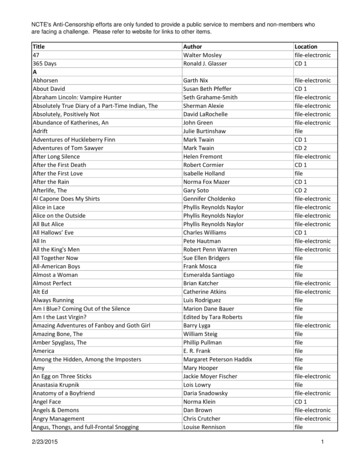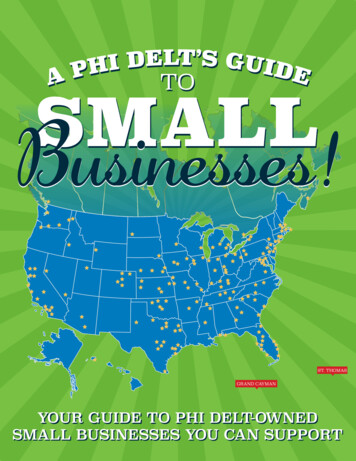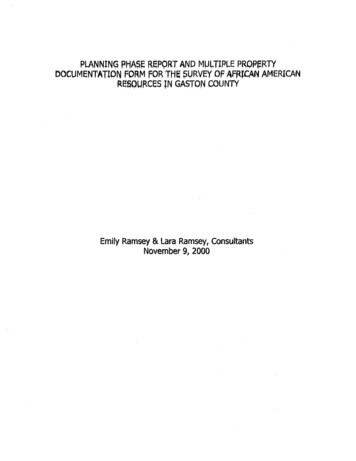
Transcription
Why Are Black-Owned Businesses Less Successful than White-Owned Businesses?The Role of Families, Inheritances, and Business Human CapitalRobert W. FairlieVisiting Fellow, Economic Growth Center, Yale University and Department ofEconomics, University of California, Santa Cruzrfairlie@ucsc.eduAlicia M. RobbBoard of Governors of the Federal Reserve System and Foundation for SustainableDevelopmentOctober 2003This research was partially funded by the Russell Sage Foundation. Research for thispaper was conducted at the Center for Economic Studies at the U.S. Census Bureau. Theviews expressed here are solely the responsibility of the authors and should not beinterpreted as reflecting the views of the Russell Sage Foundation, the U.S. CensusBureau, or the Board of Governors of the Federal Reserve System. We would like tothank Ken Brevoort, Tom Dunn, John Wolken, and seminar participants at the Winter2003 Meetings of the American Economic Association, the Board of Governors of theFederal Reserve System, the University of Maryland and the Urban Institute for theircomments. Bill Koch and Garima Vasishtha provided excellent research assistance.
AbstractFour decades ago, Nathan Glazer and Daniel Patrick Moynihan made theargument that the black family "was not strong enough to create those extended clans thatelsewhere were most helpful for businessmen and professionals." Using data from theconfidential and restricted access Characteristics of Business Owners Survey, weinvestigate this hypothesis by examining whether racial differences in family businessbackgrounds can explain why black-owned businesses lag substantially behind whiteowned businesses in sales, profits, employment size and survival probabilities?Estimates from the CBO indicate that black business owners have a relativelydisadvantaged family business background compared with white business owners. Blackbusiness owners are much less likely than white business owners to have had a selfemployed family member owner prior to starting their business and are less likely to haveworked in that family member's business. We do not, however, find sizeable racialdifferences in inheritances of business. Using a nonlinear decomposition technique, wefind that the relatively low probability of having a self-employed family member prior tobusiness startup among blacks does not generally contribute to racial differences in smallbusiness outcomes. Instead, the lack of prior work experience in a family businessamong black business owners, perhaps by limiting their acquisition of general andspecific business human capital, negatively affects black business outcomes. We alsofind that limited opportunities for acquiring specific business human capital through workexperience in businesses providing similar goods and services contribute to worsebusiness outcomes among blacks. We compare these estimates to contributions fromracial differences in owner's education, startup capital, geographical location and otherfactors.
1. IntroductionThe plight of African-Americans in the labor market is one of the most studiedtopics by economists, sociologists and other social scientists over the past severaldecades. Interestingly, however, much less attention has been drawn to the plight ofblacks in the main alternative form of making a living -- business ownership. More than1 out of every 10 working-age adults in the United States owns a business (U.S. Bureauof the Census 1993). Furthermore, the difference between the rate of business ownershipamong African-Americans and whites is striking. Approximately, 11.6 percent of whiteworkers are self-employed business owners, whereas only 3.8 percent of black workersare self-employed business owners. Several recent studies have examined the causes ofthe dearth of black-owned businesses and find that relatively low levels of education,assets, and parental self-employment are partly responsible (see Bates 1997, Fairlie 1999,Hout and Rosen 2000, and Robb 2002 for a few recent examples). Although these resultsare informative, they do not shed light on why black-owned firms lag behind whiteowned firms. For example, Census estimates indicate that black-owned firms have lowerrevenues and profits, hire fewer employees, and are more likely to close than whiteowned businesses (U.S. Department of Commerce 1997).The relative lack of success of black-owned businesses in the United States is amajor concern among policymakers. It is particularly troubling because businessownership has historically been a route of economic advancement for disadvantagedgroups. It has been argued, for example, that the economic success of earlier immigrantgroups in the United States, such as the Chinese, Japanese, Jews, Italians, and Greeks, isin part due to their ownership of small businesses (See Loewen 1971, Light 1972, Baron
et al. 1975, and Bonacich and Modell 1980). In addition, many states and the federalgovernment are currently promoting self-employment as a way for families to leave thewelfare and unemployment insurance rolls.1 The lack of business success among blacksalso contributes to racial tensions in urban areas throughout the United States. The recentracial conflicts between Koreans and African-Americans in many large cities are in largepart due to the presence of successful Korean-owned businesses in black communities(Yoon 1997 and Min 1996). It has also been argued that political influence comes withsuccess in small business (Brown, Hamilton, and Medoff 1990).Another reason for concern about the lack of business success among AfricanAmericans is that they have made little progress in rates of business ownership even inlight of the substantial gains in education, earnings, and civil rights that they have madeduring the twentieth century. The 3 to 1 ratio of white to black self-employment ratesnoted above has remained roughly constant over the past 90 years (Fairlie and Meyer2000). The question of why there was no convergence in racial self-employment ratesover the twentieth century is an important one. Early researchers emphasized the rolethat past inexperience in business played in creating low rates of business ownershipamong blacks. In particular, Du Bois (1899), and later Myrdal (1944), Cayton and Drake(1946) and Frazier (1957) identify the lack of black traditions in business enterprise as amajor cause of low levels of black business ownership at the time of their analyses.The lack of black traditions in business argument relies on a strongintergenerational link in business ownership. Theoretically, we might expect the link tobe strong due to the transmission of general business or managerial experience in family1See Guy, Doolittle, and Fink (1991) and Raheim (1997) for the AFDC program, and U.S.Department of Labor (1992) and Benus et al. (1995) for the UI program.2
owned businesses ("general business human capital"), the acquisition of industry- orfirm-specific business experience in family-owned businesses ("specific business humancapital"), the inheritance of family businesses, and the correlation among family membersin preferences for entrepreneurial activities.2 Past empirical research supports thisconjecture. The probability of self-employment is substantially higher among thechildren of the self-employed (see Lentz and Laband 1990, Fairlie 1999, Dunn and HoltzEakin 2000, and Hout and Rosen 2000). There is also evidence suggesting that currentracial patterns of self-employment are in part determined by racial patterns of selfemployment in the previous generation (Fairlie 1999 and Hout and Rosen 2000).Although these findings indicate that the intergenerational transmission ofbusiness ownership is important in creating racial disparities in rates of businessownership, little is known about whether it also contributes to racial disparities inbusiness outcomes conditioning on ownership. Can these patterns explain why blackowned businesses have worse outcomes than white-owned firms? In particular, do blackbusiness owners have limited opportunities for the acquisition of general and specificbusiness human capital from working in family-owned businesses and the receipt ofbusiness inheritances, in addition to less education and access to financial capital. And,can these disparities explain why black-owned businesses lag substantially behind whiteowned businesses in sales, profits, employment size and survival probabilities?Previous studies have not examined these issues in detail primarily because only afew nationally representative datasets contain a large enough sample of black firms and2Dunn and Holtz-Eakin (2000) consider an additional explanation. Successful business ownersmay be more likely to transfer financial wealth to their children potentially making it easier forthem to become self-employed. Their empirical results, however, suggest that it plays only amodest role.3
information on parental and family self-employment, and to our knowledge, only onenationally representative dataset contains information on business inheritances andprevious work experience in businesses owned by family members.3 The Characteristicsof Business Owners (CBO) contains detailed information on the characteristics of boththe business and the owner, but has been used by only a handful of researchers. The lackof use appears to be primarily due to difficulties in accessing and reporting results fromthese confidential, restricted-access data. All research using the CBO must be conductedin a Census Research Data Center or at the Center for Economic Studies (CES) afterapproval by the CES and IRS, and all output must pass strict disclosure regulations.In this paper, we use data from the CBO to explore the role that intergenerationallinks in self-employment play in contributing to racial differences in small businessoutcomes, such as closures, profits, employment size, and sales. We build on previousfindings using the CBO indicating that previous work experience in a family member'sbusiness and previous work experience in a business providing similar goods and serviceshave large positive effects on small business outcomes, whereas having a self-employedfamily member and business inheritances play only a minor role (Fairlie and Robb 2003).A careful examination of how these measures of family business background differ byrace may uncover some answers. The inability of blacks to acquire general and specificbusiness human capital through exposure to businesses owned by family members maycontribute to their limited success in business ownership.3The CBO also contains information on prior work experience in a managerial capacity and priorwork experience in a business whose goods/services were similar to those provided by the4
2. DataThe 1992 Characteristics of Business Owners (CBO) survey was conducted bythe U.S. Bureau of the Census to provide economic, demographic and sociological dataon business owners and their business activities (see U.S. Department of Commerce1997, Bates 1990a, Headd 1999, and Robb 2000 for more details on the CBO). Therewere oversamples of black-, Hispanic-, other minority-, and female-owned businesses.The survey was sent to more than 75,000 firms and 115,000 owners who filed an IRSform 1040 Schedule C (individual proprietorship or self-employed person), 1065(partnership), or 1120S (subchapter S corporation).4 Only firms with 500 or more insales were included. The businesses included in the CBO represent nearly 90 percent ofall businesses in the United States (Department of Commerce, 1996b). Response ratesfor the firm and owners surveys were approximately 60 percent. All estimates reportedbelow use sample weights that adjust for survey non-response (Headd, 1999).The CBO is unique in that it contains detailed information on both thecharacteristics of business owners and the characteristics of their businesses. Forexample, owner characteristics include education, detailed work experience, hoursworked in the business and how the business was acquired, and business characteristicsinclude profits, sales, employment and industry. Additional advantages of the CBO overother nationally representative datasets for this analysis are the availability of measures ofbusiness ownership among family members and the large oversample of black-ownedbusinesses. In particular, the CBO contains information on business inheritances,owner's business.4Larger C corporations were not included because of the difficulty in asking owner questions formany investors. C corporations as a tax filing status, however, are becoming less popular relativeto S corporations due to changes in tax laws (Headd 1999).5
business ownership among family members, and prior work experience in a familymember's business. The main disadvantage is that the CBO does not contain informationon a comparison group of wage/salary workers. Therefore, we cannot explore the causesof racial differences in the rates of business ownership. We can, however, examine thedeterminants of racial patterns in several business outcomes, such as closure rates, sales,profits, and employment size.The sample used below includes firms that meet a minimum weeks and hoursrestriction. Specifically, at least one owner must report working for the business at least12 weeks in 1992 and at least 10 hours per week.5 The weeks and hours restrictions areimposed to rule out very small-scale business activities such as casual or side-businessesowned by wage/salary workers. In multi-owner firms, which represent 20.6 percent ofthe sample, we identify one person as the primary owner of the business. The primaryowner is identified as the owner working the most annual hours in 1992 (weeks*hours).In the case of ties, we identify the primary owner as the person who founded the business.Finally, all remaining ties are resolved by assigning a random owner. The primarybusiness owner is used to identify all owner characteristics of the firm, such as maritalstatus, education, prior work experience, and family business background. The race andsex of the firm, however, are identified by majority ownership, which is the method usedby SMOBE/SWOBE (U.S. Bureau of the Census, 1996, Robb 2000).656This restriction excludes 22.1 percent of firms in the original sample.The race of the primary owner is not available in the CBO, and the sex of the owner had many6
3. Racial Differences in Small Business OutcomesBlack-owned firms have worse outcomes than white-owned firms. Table 1reports estimates of closure rates between 1992 and 1996, and 1992 profits, employmentsize, and sales from the CBO. The magnitude of these differences in business outcomesis striking. For example, only 13.9 percent of black-owned firms have annual profits of 10,000 or more, compared to 30.4 percent of white-owned firms. In fact, the entiredistribution of business net profits before taxes for black-owned firms is to the left of thedistribution for white-owned firms (with the exception of the largest loss categories).7Surprisingly, nearly 40 percent of all black-owned firms have negative profits. Blackowned firms also have lower survival rates than white-owned firms. The averageprobability of business closure between 1992 and 1996 is 26.9 percent for black-ownedfirms compared to 22.6 percent for white-owned firms.8Black-owned firms are substantially smaller on average than are white-ownedfirms. Mean sales or total receipts among black-owned firms were 59,415 in 1992.Average sales among white-owned firms were nearly 4 times larger. The difference isnot simply due to a few very large white firms influencing the mean. Median sales forblack firms were one half that of white firms, and the percent of black firms with sales of 100,000 or more was less than half the percent of white firms. Black-owned firms alsohire fewer employees than white-owned firms. On average, they hire only 0.63missing values.7The CBO only includes a categorical measure for profits.8Although sample weights are used that correct for non-response, there is some concern thatclosure rates are underestimated for the period from 1992 to 1996. Many businesses closed ormoved over this period and did not respond to the survey which was sent out at the end of theperiod. Indeed, Robb (2000) showed, through matching administrative records, thatnonrespondents had a much higher rate of closure than respondents. Racial differences in closurerates, however, were similar across the respondents and nonrespondents.7
employees, whereas white-owned firms hire 1.80 employees. Interestingly, only 11.3percent of black-owned firms hire any employees. In comparison, 21.4 percent of whiteowned firms hire at least 1 employee.Estimates from other data sources paint a similarly bleak picture for the state ofblack business. Closure rates are high among black-owned firms (Bates 1997, Robb2000, Boden and Headd 2002, and Robb 2002). Data from the Survey of Small BusinessFinances show that black owned businesses had lower sales, employment, and profits, aswell has higher bankruptcies and credit risk ratings (Bitler, Robb, and Wolken, 2001).Using data from the Panel Study of Income Dynamics, Fairlie (1999) finds that theannual exit rate from self-employment for black men is twice the rate for white men.4. Racial Differences in Family Business BackgroundAn extensive literature addresses the "breakdown" of the African-Americanfamily (Wilson 1987, Tucker and Mitchell-Kernan 1995, Wilson 2002). Blacks are 40.1percent less likely to be married than are whites, and black women are 78.8 percent morelikely to have an out-of-wedlock birth than are white women (U.S. Bureau of the Census2001 and National Center for Health Statistics 2002). The result is that 53.3 percent ofblack children live with only one of their parents compared to 21.5 percent of whitechildren (U.S. Bureau of the Census 2001). In addition, previous research indicates thatthe probability of self-employment is substantially higher among the children of the selfemployed than among the children of the non-self-employed (see Lentz and Laband1990, Fairlie 1999, Dunn and Holtz-Eakin 2000, and Hout and Rosen 2000). Thesestudies generally find that an individual who had a self-employed parent is roughly two to8
three times as likely to be self-employed as someone who did not have a self-employedparent. The high incidence of growing up in a single-parent family and the strongintergenerational link in self-employment may limit business ownership opportunities forblacks.Concerns about the negative consequences of weak family ties on businessopportunities among blacks are not new. In fact, four decades ago Nathan Glazer andDaniel Patrick Moynihan made the argument that the black family "was not strongenough to create those extended clans that elsewhere were most helpful for businessmenand professionals (Glazer and Moynihan 1970, p.33)." More recently, Hout and Rosen(2000) note a "triple disadvantage" faced by black men in terms of business ownership.They are less likely than white men to have self-employed fathers, to become selfemployed if their fathers were not self-employed, and to follow their father in selfemployment. Furthermore, Fairlie (1999) provides evidence from the PSID that currentracial patterns of self-employment are in part determined by racial patterns of selfemployment in the previous generation.We know less, however, about whether blacks and whites differ in workexperience in family businesses and their likelihood of receiving business inheritances,and whether these patterns contribute to why black firms are less successful than whitefirms. Estimates from the CBO indicate that black and white primary business ownershave different family business backgrounds. Table 2 reports the percentage of ownersthat had a family member who was a business owner and the percentage of owners thatworked for that family member.9 More than half of all white business owners had a self9The questions ask (1) "Prior to beginning/acquiring this business, had any of your close relativesever owned a business OR been self-employed? (Close relatives refer to spouses,9
employed family member owner prior to starting their business. In contrast,approximately one-third of black business owners had a self-employed family member.Although family members may include spouses and siblings in addition toparents, these findings are consistent with Hout and Rosen's (2000) finding of a lowerprobability of self-employment among the children of self-employed parents (the"intergenerational pick up rate with respect to self-employment") for blacks than forwhites.10 To see this, we express the joint probability of having a self-employed parent(St-1 1) and child (St) as:(4.1)P(St 1, St-1 1) P(St 1 St-1 1)P(St-1 1) P(St-1 1 St 1)P(St 1).Assuming a steady state equilibrium, St St-1 and one-to-one matching of parents tochildren, the intergenerational pick up rate equals the probability of a business ownerhaving a self-employed parent. We find a black/total ratio of .632 for the probability ofhaving a self-employed family member, which is in the range of Hout and Rosen's (2000)estimates.Family businesses may provide important opportunities for acquiring general andspecific business human capital (Lentz and Leband 1990, Fairlie and Robb 2003).Estimates from the CBO indicate that conditional on having a self-employed familyparents/guardians, brothers, sisters, or immediate family)", and (2) "If "Yes," did you work forany of these relatives?" (U.S. Department of Commerce 1997, p. C-4).10The percent of owners that had a self-employed family member prior to business startupcertainly overstates the percent of owners that had a self-employed parent, but the discrepancymay not be that large. The strong positive influence of parental self-employment is common tobrothers suggesting that a propensity for business ownership runs in families (Dunn and HoltzEakin 2000), and the question on the CBO asks whether the owner had a self-employed familymember prior to starting his/her business limiting the likelihood that older siblings are referringto younger self-employed siblings. Furthermore, estimates from the 2002 Current PopulationSurvey indicate that the average probability of having a self-employed spouse among all selfemployed business owners is only 24 percent. We suspect that a large percentage of affirmativeresponses to the CBO question on whether the owner had a self-employed family member prior tostarting his/her business refer to the owner's parents.10
member, black business owners were also less likely to have worked for that person thanwere white business owners. Only 37.4 percent of black business owners who had a selfemployed family member worked for that person's business, whereas 43.9 percent ofwhite business owners who had a self-employed family member worked for that person'sbusiness.11 Finally, black business owners overall were much less likely than whitebusiness owners to work for a family member's business. The unconditional rate ofworking for family member's business was 12.6 percent for blacks and 23.3 percent forwhites.Black business owners were slightly less likely to inherit their businesses thanwere white owners (Table 2). Only 1.4 percent of black owners inherited their firmscompared to 1.7 percent of white owners. These rates of inheritance are very low andsuggest that racial differences in inheritances cannot explain much of the gaps in smallbusiness outcomes.Overall, the estimates reported in Table 2 indicate that black business ownershave a relatively disadvantaged family business background compared to white businessowners. The lack of family business experience may contribute substantially to therelative lack of success of black-owned businesses because of limited opportunities toreceive the informal learning or apprenticeship type training that occurs in working in afamily business. Family businesses provide an opportunity for family members toacquire general business human capital and in many cases also provide the opportunityfor acquiring specific business human capital. The impact of racial differences in theseopportunities on racial differences in small business outcomes, however, is an open11These patterns may in part be due to lower employment levels among black-owned firms.11
question. To answer this question we next investigate the determinants of small businessoutcomes.5. The Determinants of Small Business OutcomesTo better understand why racial differences in business outcomes exist, we firstmodel the determinants of small business outcomes. Logit and linear regression modelsare estimated for the probability of a business closure from 1992-1996, the probabilitythat the firm has profits of at least 10,000 per year, the probability of having employees,and log sales.12 Table 3 reports estimates. We include the race, sex, region andurbanicity of the firm, and the education level, marital status and previous workexperience of the owner as controls. We also include the family business backgroundvariables listed in Table 2 and two related business experience variables.After controlling for numerous owner and business characteristics, black-ownedbusinesses continue to lag behind white-owned businesses. In all specifications exceptthe closure probability equation, the coefficient estimate on the black-owned businessdummy variable is large, positive and statistically significant. In the closure probabilityequation, the coefficient estimate is positive, but statistically insignificant. Evidently, ourregressors cannot explain all of the differences between blacks and whites in smallbusiness outcomes (we discuss these issues further in the next section).12Although the profit measure is categorical, we do not estimate an ordered model because of thedifficulty in interpreting the decomposition results that follow. The regression and decompositionresults using a cutoff of 25,000 are similar to those reported below. The other possible cutoff of 100,000 yielded too few observations in which the dependent variable equals one. We also use alogit model for the employment probability because most of the variation in employment amongsmall businesses is between 0 and 1 employee. Roughly 80 percent of firms have no employeesand only a small percent have more than 5 employees.12
Similar to previous studies, we find that small business outcomes are positivelyassociated with the education level of the business owner.13 For example, businesseswith college-educated owners have a 0.055 lower probability of closure, a 0.113 higherprobability of having large profits, a 0.060 higher probability of having employees, andhave approximately 25 percent higher sales on average than businesses with owners whodid not graduate from high school.14 Female-owned businesses are less successful andare smaller on average than are male-owned businesses. Firms located in urban areas aremore likely to close and are less likely to have employees, but are more likely to havelarge profits and have higher sales than firms located in non-urban areas.Having a family business background is important for small business outcomes.15The main effect, however, appears to be through the informal learning or apprenticeshiptype training that occurs in working in a family business and not from simply having aself-employed family member. The coefficient estimates on the dummy variableindicating whether the owner had a family member who owned a business are small andstatistically insignificant in all of the specifications except for the closure probabilityequation. In contrast, working at this family member's business has a large positive andstatistically significant effect in all specifications. The probability of a business closure is0.042 lower, the probability of large profits is 0.032 higher, the probability ofemployment is 0.055 higher, and sales are roughly 40 percent higher if the businessowner had worked for one of his/her self-employed family members prior to starting the13For example, using the 1982 CBO, Bates (1990b) finds that small business failures generallydecrease with the education level of the owner.14The implied effects on the probability of closure, profits, and employment are approximated bymultiplying the coefficient estimate from the logit model by p (1 p ) , where p is the mean ofthe dependent variable.15See Fairlie and Robb (2003) for a more detailed discussion of the effects of family business13
business.16 The effects on the closure, profit and employment probabilities represent 15.3to 26.6 percent of the sample mean for the dependent variables.Perhaps not surprisingly, inherited businesses are more successful and larger thannon-inherited businesses. The coefficients are large, positive (negative in the closureequation) and statistically significant in all specifications. Inheritances may represent aform of transferring successful businesses across generations, but their overallimportance in determining small business outcomes is slight at best. Although thecoefficient estimates are large in the small business outcome equations, the relativeabsence of inherited businesses (only 1.6 percent of all small businesses) suggests thatthey play only a minor role in establishing an intergenerational link in self-employment.17The strong effect of previous work experience in a family member's business onsmall business outcomes suggests that family businesses provide an importantopportunity for family members to acquire human capital related to operating a business.The general lack of significance of having a self-employed family member may indicatethat correlations across family members in entrepreneurial preferences are less importantin creating an intergenerational link in business ownership.The CBO also provides detailed information on other forms of acquiring generaland specific business human capital. Available q
3 owned businesses ("general business human capital"), the acquisition of industry- or firm-specific business experience in family-owned businesses ("specific business human










